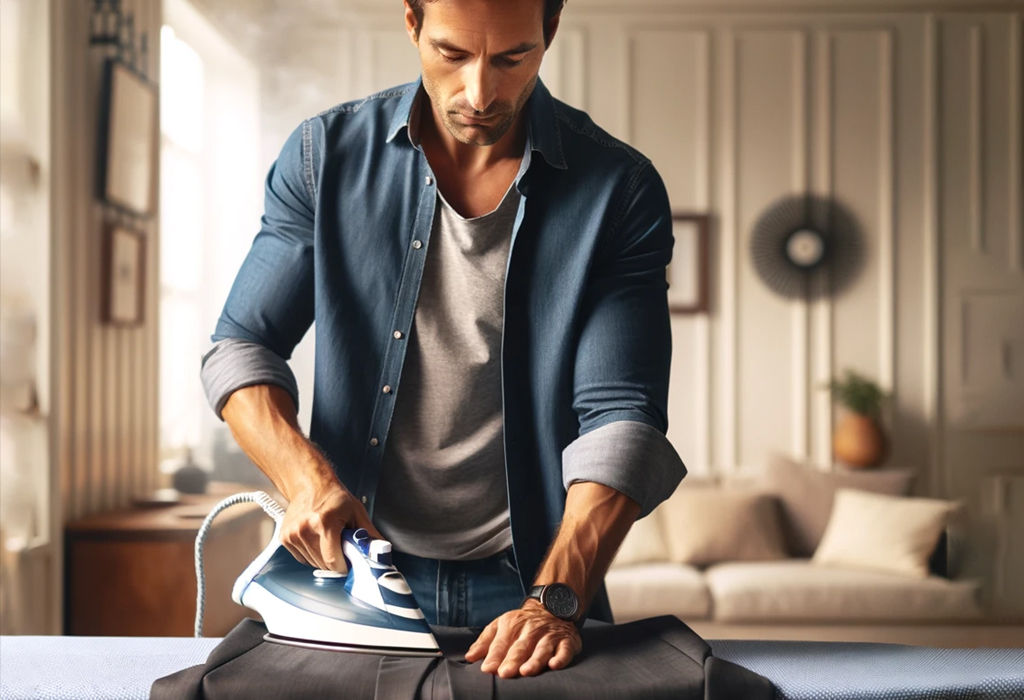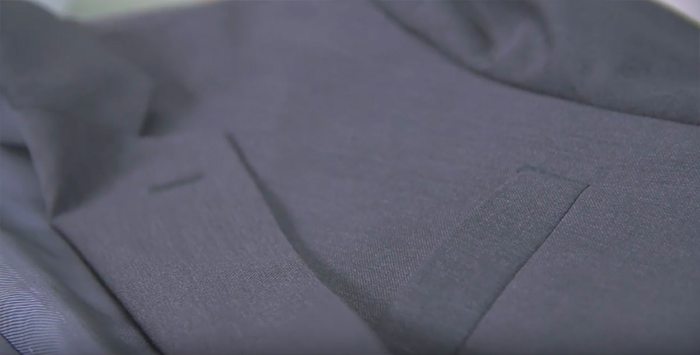The suit jacket.
It's easily one of the most important pieces in your wardrobe.
Your go-to item whenever you need to look your best.
Unfortunately…
Like all clothing…
It will eventually develop wrinkles over the course of multiple wears.
So – how do you overcome this problem?
In today’s article and video…
We are going to discuss how to steam and press a suit jacket.
(Two different solutions to take care of one major issue)
Keep on reading to learn more.
The most well-known method to get rid of wrinkles is to send your jacket to the cleaners to be professionally pressed. And without a doubt – this yields the best result, as they have the equipment and experience to get the job done right.
However, if you are having your jacket pressed often…this can quickly get expensive. So even though you should get your jacket professionally pressed now and then, what can you do at home between pressings?
That's where the following methods listed below come in handy.
Maintaining A Suit Jacket: Method #1 – Steaming
To get started with method one, here is what you will need:
A Steamer – There are two main types of steamers: (1) smaller ones for traveling and (2) full sized ones for at home.
If you will often be steaming multiple items of clothing at once, a full-size steamer will work best. If you travel frequently or just need the occasional touch-up, then the travel size will be perfect for your needs.
A Clean Jacket – You want to make sure your jacket is free from stains and dirt. Heat and steam can permanently set stains.
Distilled Water – Only use distilled water in your steamer, as tap water can leave sediment buildup that will decrease the steamer’s effectiveness over time.
A Hanger – You’ll need to hang your jacket in order to steam it. Only use wide shouldered hangers. You can hang your jacket in your closet if there is enough room. Hanging it on your shower curtain rod also works well.
To start, fill your steamer with distilled water and turn it on. Give it 2-3 minutes to fully heat up (but it may take longer if you are using a full-size steamer with a lot of water).

You will steam the jacket in sections, pulling the fabric taut before pressing the steamer head to the fabric. Slowly move the steamer in an up-and-down motion, pulling the trigger to let out steam every few seconds. If the wrinkles aren’t coming out – you may be moving the steamer too quickly.
The primary areas that will likely need attention will be around the elbows, the back of the jacket, and maybe a few small spots on the front of the jacket.

Be careful not to over-steam, as using an excessive amount of steam around the seams can cause them to lose their shape.
This is a very easy method to get rid of wrinkles. And it has a very low risk of damaging the jacket.
But maybe you don’t have a steamer, or perhaps you have a wrinkle that needs something more powerful. In that case – the next method is for you.
Maintaining A Suit Jacket: Method #2 – Ironing
Here is what you will need to iron your jacket:
A Clean Iron – You need to make sure your iron is clean (as it can leave stains if it has rust or sediment buildup). Test for this by ironing a white rag to see if it will leave stains.
To get rid of sediment buildup, you will run a solution of 50% vinegar and distilled water through the steamer function.
A Clean Jacket – Again, you must make sure the jacket is free from dirt and stains to avoid permanently setting them in the fabric.
A Standard Ironing Board – It’s much easier to use a board than ironing on a table. The board doesn’t need to be fancy (the basic ironing board found at any department store will do nicely).
Distilled Water – You must use distilled water in the iron, as regular water can lead to sediment buildup. Using the steam function of the iron makes it easier to press out wrinkles.
A Pressing Cloth – Most jackets are made from delicate fabrics like wool that can easily be damaged by the hot iron. To protect your jacket from scorches or shiny marks, you will place a piece of cloth between the iron and jacket. A simple white handkerchief works perfectly for this.
To start, set your iron to the right heat setting for your fabric. Always check the care label on your jacket to ensure you don’t damage the fabric.
The general rule is low heat for synthetic fabrics, low to medium heat for wools, and high heat for linen and cotton. It’s always best to start at a lower temperature to avoid damaging the fabric – and then slowly increase if necessary.
Use the pressing method instead of sliding the iron like you would for a dress shirt. Press the iron evenly on top of the fabric for a few seconds, then pick it straight up and move to another spot. (Warning: sliding the iron back and forth can lead to shiny marks on the fabric.)

A jacket is rather difficult to iron, especially around the shoulders. I highly recommend only pressing areas that really need attention like the back, elbows, and parts of the front. The rest should be left to the dry cleaner.
To iron, the back of the jacket, lay it out flat on the ironing board. Smooth out the fabric so you will not make any creases. Carefully press out the wrinkles by setting the iron straight down and picking it up again before moving to a new spot. Again, focus only on wrinkled areas. When ironing over the vents – make sure they are aligned properly.
When it comes to the sleeves, only iron in the middle. If you press the iron on the edges – you will form a crease. While this might look good on a dress shirt, it is undesirable on a jacket.

If the front of the jacket needs attention, be sure to pull out the pocket linings before pressing around the pockets (to avoid leaving impressions in the fabric).
Be careful around the jacket lapels, as this is another area where you don’t want to create a crease. If you need to iron the lapels, go over them very gently with the iron.

There you have it, gentlemen. Though you will still need to get your suits professionally cleaned and pressed now and then, these two methods are fantastic ways to make sure your jacket always looks its best before any occasion.
The post How To Steam And Press A Suit Jacket | Guide To Cleaning Jackets appeared first on Real Men Real Style.
0 Commentaires